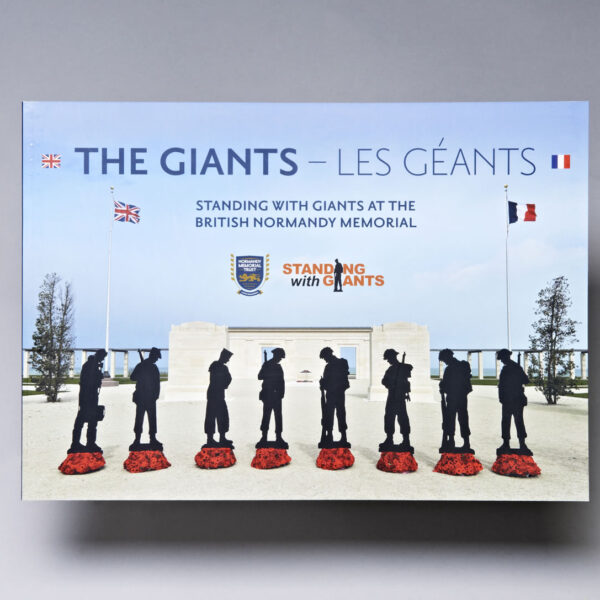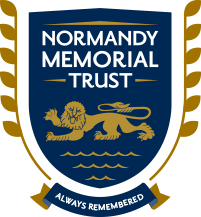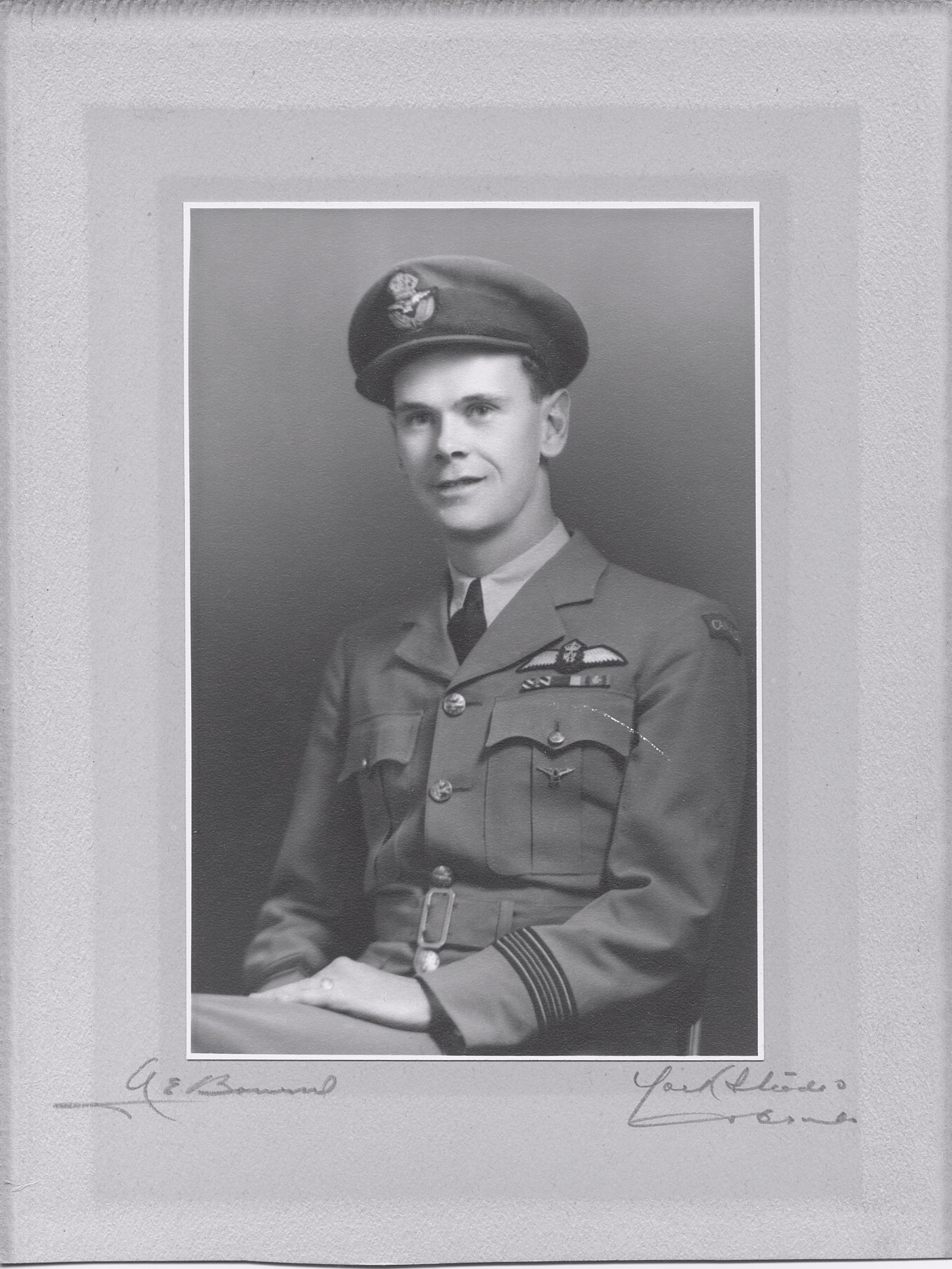
Wilmot Reginald Pettit
This story and photos are shared by the Trust with kind permission from Mavis Williams, Researcher
Wilmot Reginald Pettit was born on the 3rd of April 1912, the son of Harry Augustus & Kathleen Pettit (née Kitchen) in Brantford, Ontario. His home address was 57, Murray Street, Brantford, Ontario, Canada.
He joined up on the 10th of September 1940. His Attestation Paper states that he was a Salesman, a Baptist and his Languages were English and some French. His father Harry Augustus Pettit had been born in Delhi, Ontario, he was a 'Traveller' for the Stanley Works of Canada. His mother, Kathleen Kitchen, had been born in Paris, Ontario.
Wilmot was educated at Dufferin Public School and Brantford Collegiate, Brantford, Ontario from 1927 - 1933 (Jr. Matric, plus some Snr. Matric). He was a keen sportman and played golf, tennis and badminton as well as skiing, swimming and hockey. He also played the clarinet.
When he joined up, Wilmot was single, age 28 and ¼ years old, 5 feet 11 inches tall, and weighed 156lbs. He was interviewed for an Observer in the Royal Canadian Air Force at Ottawa. The summary of the interview was that “This young man has Junior Matric also some Senior Matric. Has been successful in business life. Nice looking, clean, smart, intelligent - alert – Officer Calibre. Wants to be a Pilot but over age – Recommended Observer.” It was noted he was “Above Average.”
Despite the recommendation that he was too old to be a pilot, he did the pilot course and got his pilot's badge in July 1941. His training reports stated that he was a "An above average pilot. Flying is sound." "Smooth confident student. Shows excellent air-sense at all times No outstanding weaknesses." He served as a Sergeant and then Sergeant Pilot before being commissioned in May 1942.
He was awarded the DFC in September 1943 after taking part in a raid on Berlin. The citation states:
"As pilot, this officer has participated in many attacks on important enemy targets and has displayed great skill and determination. On a recent occassion whilst over Berlin, His aircraft was hit by fire from the ground defences but he continued his bombing run to execute a successful atatck. Shortly afterwards, the bomber was hit again, this time by fire from an enemy fighter. The rear turret was rendered unserviceable, most of the electrical system was shot away, while the control wires of the petrol tanks were severed. Coolly and skilfully Flight Lieutenant Pettit evaded the attacker and flew the bomber to base. This officer displayed great courage and determination throughout"
By April 1944 he had been promoted to acting Squadron Leader. The report said he was " A fine operational pilot and excellent Flight Commander, S/L Pettit is justly respected and esteemed by all ranks. He is a very good and steady influence among aircrew, especially, and with some more experience as Flight Commander should make a first class Squadron Commander"
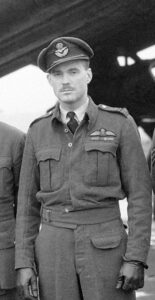
In May 1944, when officer-in-charge of night flying, he was awarded the OBE for rescuing three members of the crew of an aircraft which overshot the runway and overturned in the middle of some very swampy ground. With the help of the fire party, led by Leading Aircraftsman Wray, he rescued two members of crew and then found the rear gunner, seriously injured and trapped upside down in the turret. Despite the fact the aircraft was on fire, the petrol tanks had begun to explode and there was a high risk of explosions from the ammunition, the citation explained what happened next:
"Squadron Leader Pettit decided to attempt the extremely difficult task of removing the rear turret competely from the fuselage as all other attempts to reach the trapped gunner had failed. By strenuous effort he was ultimately able to get into the turret while a party, headed by Aircraftsman Wray, wrenched at it from outside. Eventually the gunner was extricated alive and without any addition to the severe injuries which he had sustained in the crash. Squadron Leader Pettit's coolness, courage and initiative and Leading Aircraftsman Wray's determination and devotion to duty in dangerous circumstances, were of a very high order and were instrumental in saving the lives of three members of the crew of the aircraft."
On the night of 5/6th June he was the pilot in Stirling Mk.IV EF295, 620 Squadron, Royal Air Force (RAF). They took off at 23:45 on the from RAF Fairford, Gloucestershire to transport parachutists of 591 Parachute Squadron, 6th Airborne Division to a drop zone east of the River Orne for Operation Tonga (the landings by 6th Airborne Division on D-Day).
But the aircraft was hit by German anti-aircraft fire and crashed eight miles east of the drop zone near Château de Grangues, Grangues, Calvados before it could drop the parachutists. He was killed in the crash. He had completing one tour of operations and he could have returned to Canada after that but he volunteered for further duty and had just started his second tour when he was killed.
He was engaged to be married to Miss Florence Spencer of 20 Stevenson Street, Ottowa. Her search to find information about details of his death was a common one for families. She had written to the RCAF Casualty office a number of times to find out what had happened to him and also his crew. In her letter of January 9th 1945 she wrote:
"I wonder if you had received any further information on Sqdn/Ldr. Pettit W.R J15517 since last October when he was reported "believed killed". In the letter that followed the telegram you said he had been buried by the farmer in France and you were going to forward the exact place etc. as soon as you received this information.
Any information about Sqdn/Ldr Pettit of any of his crew would mean so much to me; what happened to their aircraft or anything you are permitted to tell me.
You have always been very kind when I bothered you so often during the anxious months when he was missing and I want you to know that I appreciated it so very much
Yours very sincerely,
(Miss) Florence Spencer”
His death in action was reported in the local Ottawa press as seen in this clipping:
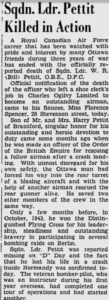
The bodies of Sqn Ldr Pettit and his crew were first buried near the crash site before being moved to temporary graves at Ranville Cemetery on the 1st June 1945. They were reinterred in their final resting place in Ranville Cemetery on the 10th of August 1945.
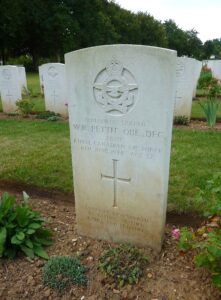
British Normandy Memorial - Additional Information
We also have a story about a crew member in Wilmot's aircraft, Geoffrey Albert Maund. You can find out about him here.
FALLEN HEROES
WILMOT REGINALD PETTIT
Royal Air Force • SQUADRON LEADER
Royal Canadian Air Force
620 Squadron, Royal Air ForceDIED | 06 June 1944
AGE | 32
SERVICE NO. | J/15517
FALLEN HEROES
WILMOT REGINALD PETTIT
Royal Air Force • SQUADRON LEADER
Royal Canadian Air Force
620 Squadron, Royal Air ForceDIED | 06 June 1944
AGE | 32
SERVICE NO. | J/15517




